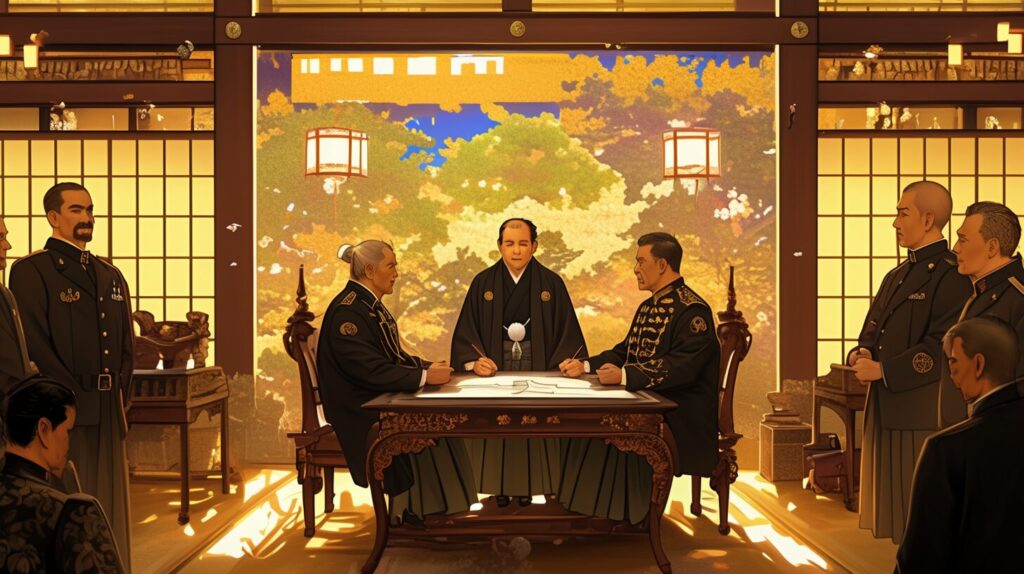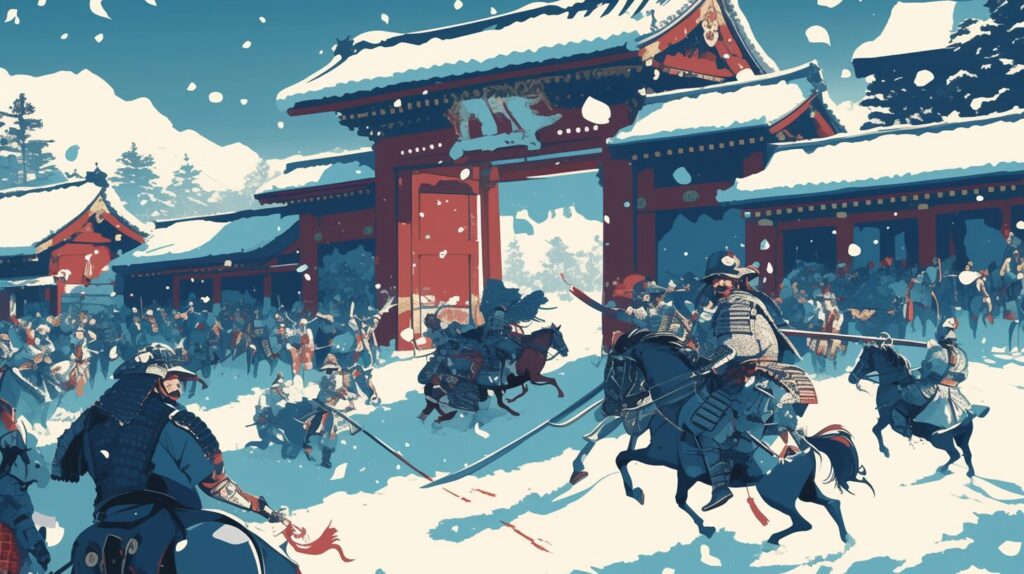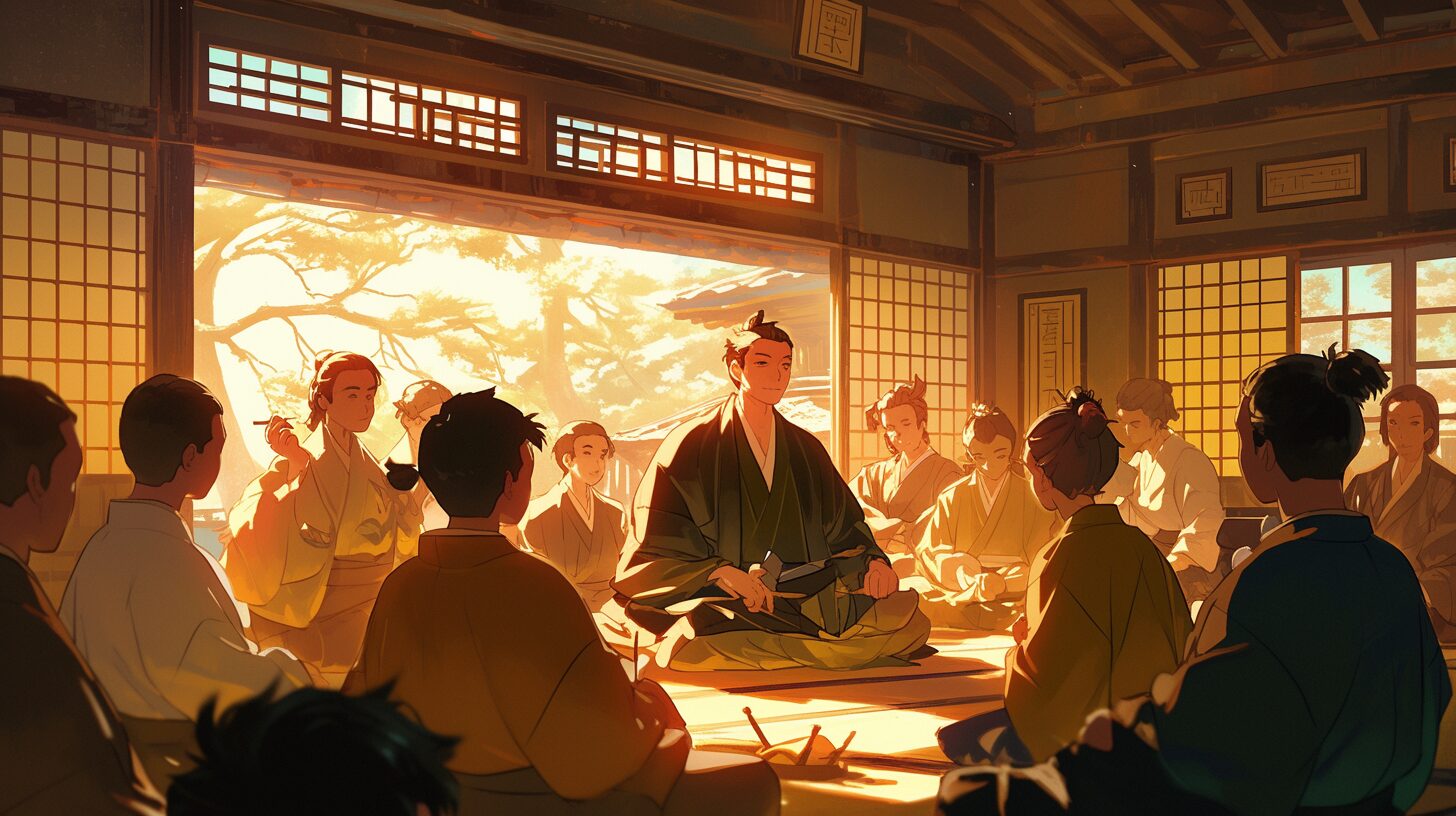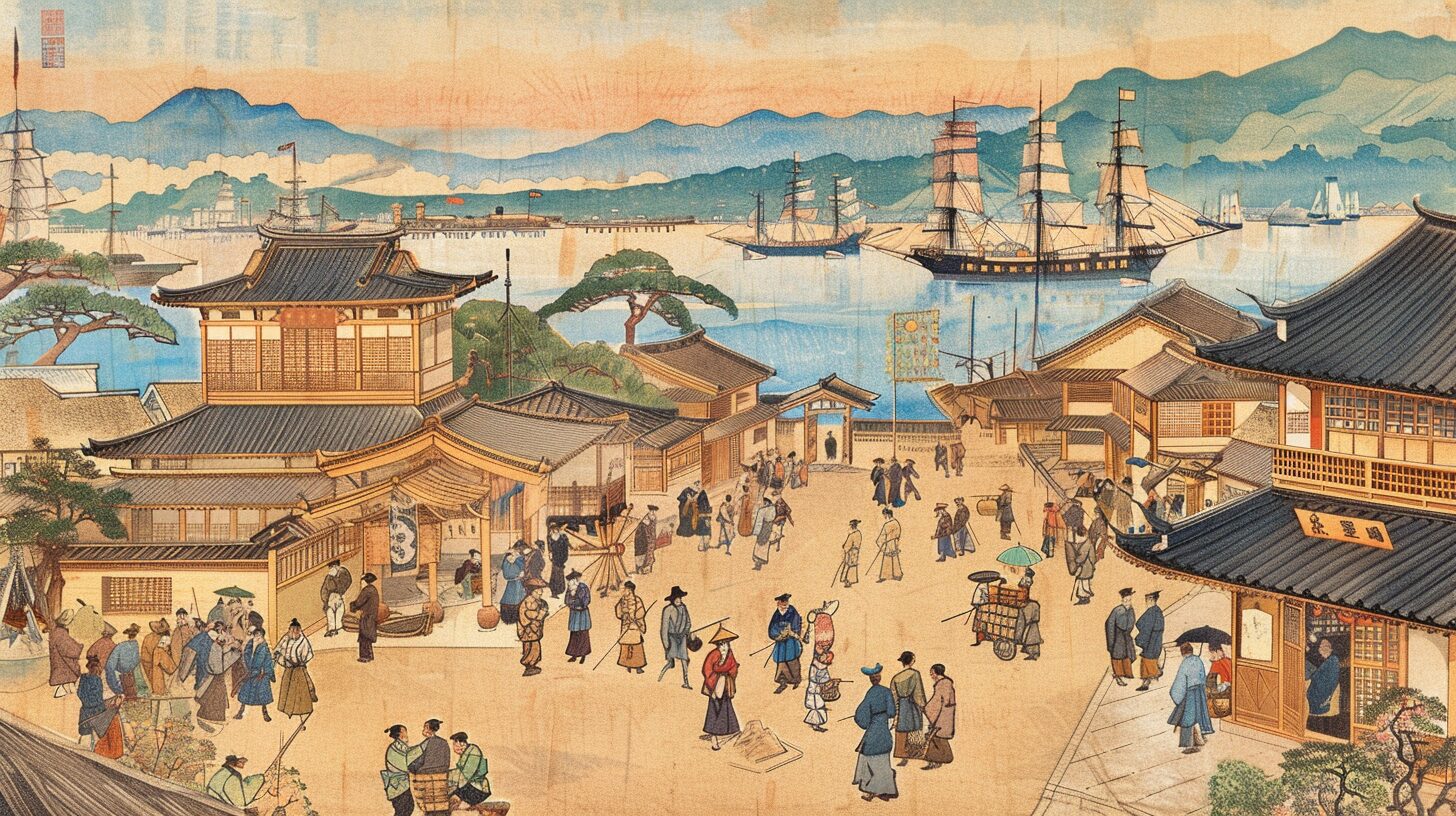安政の大獄を英語で説明・紹介するための基本情報と、英会話に役立つ表現をシンプルでわかりやすい英語で紹介します。
英会話ダイアローグ・概要・10の質問を通して、安政の大獄に関する英語表現を学びます。
英語
英会話ダイアローグを読む前に知っておくと良い前提知識と情報です。
- 幕末の日本と開国問題
- 江戸時代(1603~1868年) は、「鎖国政策」によりオランダ・中国など限られた国としか貿易していなかった
- 1853年、アメリカのペリー提督が軍艦(黒船)を率いて来航し、日本に開国を要求
- 日本は軍事力で圧倒され、1854年に日米和親条約を結び、開国
- 1858年、日米修好通商条約 を締結、これにより日本は本格的に外国との貿易を開始したが、この条約は 不平等条約 だったため、国内で反対運動が起こった
- 「尊王攘夷」(天皇を敬い、外国を排除しようとする考え方)が広まり、幕府の力が弱まっていった
- 幕府の内部対立と将軍継嗣問題
- 当時の将軍・徳川家定は病弱で子供がいなかった
- そのため、「次の将軍を誰にするか?」で幕府内の対立が起こった
- 候補者は2人:
- 徳川家茂:井伊直弼ら保守派が支持
- 徳川慶喜:改革派や朝廷が支持
- 井伊直弼は強引に 家茂を将軍に決定、反対派は激しく抗議したが、井伊直弼は彼らを弾圧するために「安政の大獄」を実施
- 安政の大獄とその影響
- 安政の大獄(1858~1859年) とは、井伊直弼が反対派を弾圧・処刑 した事件
- 井伊直弼は多くの敵を作り、1860年の桜田門外の変で暗殺された
- 幕府の権威はますます低下し、最終的に1868年の明治維新につながる
- 処罰された人物
- 吉田松陰:長州藩の思想家、幕府批判により処刑
- 橋本左内:福井藩の学者、改革派のリーダーとして処刑
- 重要な出来事の流れ
- 1853年:ペリー来航
- 1858年:日米修好通商条約締結
- 1858-59年:安政の大獄
- 1860年:桜田門外の変
- 1868年:明治維新
2人が安政の大獄について話しています。
日米修好通商条約の締結や将軍継承問題など、安政の大獄の背景から、井伊直弼による弾圧、その後の桜田門外の変、明治維新への影響などを話題にしています。
会話 / dialogue

Hey, Key. Lately, I’ve been really interested in Japanese history, and I came across something called the Ansei Purge. It sounds like a huge event, but I don’t fully understand it. Do you know much about it?

Oh, yeah! The Ansei Purge was a big political crackdown in 1858 and 1859, led by Ii Naosuke, a powerful official of the Tokugawa shogunate. It had a massive impact on Japan’s history.

Wow, I had no idea. Why did it happen?

Well, at that time, Japan had been isolated from the rest of the world for over 200 years. But in 1853, an American naval officer, Commodore Perry, arrived in Japan with warships and demanded that Japan open its ports to trade.

Ah, I think I’ve heard about that! He came with the “black ships,” right?

Exactly! Japan had no choice but to agree, and a few years later, in 1858, the shogunate signed the Treaty of Amity and Commerce with the U.S..

Was that a fair deal?

Not at all! The treaty was unequal and gave more benefits to the U.S. than to Japan. Worse, the shogunate signed it without getting the Emperor’s approval, which made many people, especially those who wanted to protect Japan from foreign influence, extremely angry.

So, the treaty made people angry, but was that the only reason for the Ansei Purge?

No, there was also a struggle over who would become the next shogun. The current shogun, Tokugawa Iesada, was very sick and had no children.

So they needed to decide who would take over?

Exactly. There were two main candidates:
・Tokugawa Iemochi – supported by Ii Naosuke and conservative officials.
・Tokugawa Yoshinobu – supported by reformists and people loyal to the Emperor.

Let me guess… Ii Naosuke wanted Iemochi to become the next shogun?

Yep! And when people protested against his decision, he used his power as Tairo (Senior Minister) to eliminate his political enemies. That’s how the Ansei Purge began.

How did he eliminate his enemies?

Ii Naosuke arrested and punished over 100 people—including samurai, scholars, nobles, and lords who opposed him. Some were forced to retire, some were put under house arrest, and a few were even executed.

That sounds brutal. Who were some of the people who got punished?

One of the most famous was Yoshida Shoin, a samurai and thinker from Choshu domain. He was executed in 1859 because he opposed the shogunate’s policies. Another was Hashimoto Sanai, a scholar from Fukui domain, who was also executed.

Wow. But what happened to Ii Naosuke? Did he stay in power?

No. His enemies didn’t forget what he did. In 1860, a group of samurai from the Mito domain assassinated him in front of Edo Castle in what is known as the Sakuradamon Incident.

Whoa! So his strict rule didn’t last long.

Right. His death weakened the shogunate, and opposition to the government grew even stronger.

So, what happened after he was killed?

The anti-shogunate movement became much stronger. The shogunate tried to keep control, but more people supported the Emperor instead. By 1868, the shogunate collapsed, and the Meiji Restoration began.

That’s when Japan modernized, right?

Yep! The Emperor became the ruler, and Japan adopted Western-style government and military reforms.

That’s an incredible story. It’s amazing how one political purge helped lead to the end of the samurai era.

Yeah, it was definitely a turning point in Japanese history. If you’re really interested, you should visit Sakuradamon Gate in Tokyo. That’s where Ii Naosuke was assassinated!

That sounds awesome. Let’s go this weekend!

Sure! I’ll tell you more stories when we get there.
概要 / Overview
「安政の大獄」について、理解を深めるための「英語での概要」です。
安政の大獄

Introduction
The Ansei Purge was a major political event in Japan between 1858 and 1859. It was led by Ii Naosuke, a powerful official of the Tokugawa shogunate. This event was a crackdown on people who opposed the shogunate’s policies. Many samurai, scholars, and nobles were punished, and some were even executed. The purge had a big impact on Japanese history.
Background: Japan and Foreign Countries
Before the Ansei Purge, Japan had a policy of isolation for over 200 years. However, in 1853, an American officer, Commodore Perry, arrived with warships and demanded Japan to open its ports. Japan had no choice but to accept, and in 1858, the shogunate signed the Treaty of Amity and Commerce with the U.S. This treaty was unfair to Japan, and many people were angry because the shogunate did not ask the Emperor for approval.
The Succession Dispute
At the same time, there was a struggle over who would be the next shogun. The current shogun, Tokugawa Iesada, was very sick and had no children. There were two candidates for the next shogun:
・Tokugawa Iemochi – supported by Ii Naosuke and conservatives.
・Tokugawa Yoshinobu – supported by reformists and the Emperor’s supporters.
Ii Naosuke chose Iemochi, and many people opposed his decision.
The Ansei Purge Begins
To remove his enemies, Ii Naosuke started the Ansei Purge. He arrested over 100 people, including lords, samurai, and scholars. Some were forced to retire, some were put under house arrest, and some were executed. One famous victim was Yoshida Shoin, a samurai from Choshu, who was executed in 1859.
Assassination of Ii Naosuke
The Ansei Purge created many enemies for Ii Naosuke. In 1860, a group of samurai from the Mito domain assassinated him in front of Edo Castle. This event is known as the Sakuradamon Incident.
Conclusion: Impact of the Purge
The Ansei Purge weakened the shogunate instead of making it stronger. More people opposed the government, and in 1868, the Tokugawa shogunate collapsed. This led to the Meiji Restoration, when Japan modernized and ended the samurai system.
10の質問 / 10 questions
「安政の大獄」について、理解を深めるための「英語での10の質問」です。
1: What was the Ansei Purge?
The Ansei Purge was a political crackdown in Japan from 1858 to 1859. It was led by Ii Naosuke, a high-ranking Tokugawa official, to remove people who opposed his policies.
2: Why did the Ansei Purge happen?
It happened because many people were against Japan’s trade treaties with foreign countries and the choice of the next shogun. Ii Naosuke used his power to suppress opposition.
3: Who was Ii Naosuke?
Ii Naosuke was a senior official (Tairō) of the Tokugawa shogunate. He supported Tokugawa Iemochi as the next shogun and promoted Japan’s opening to foreign trade.
4: What was the Treaty of Amity and Commerce?
It was a trade agreement between Japan and the U.S. in 1858. It allowed foreign trade but was unfair to Japan. Many people were angry because it was signed without the Emperor’s approval.
5: What was the shogunate succession dispute?
When Shogun Tokugawa Iesada became sick, there was a conflict over who should be the next shogun. One side supported Tokugawa Iemochi, while the other supported Tokugawa Yoshinobu.
6: Who were the main victims of the Ansei Purge?
Many samurai, scholars, and nobles were punished. Some were executed, like Yoshida Shoin and Hashimoto Sanai. Others were placed under house arrest or forced to retire.
7: What happened to Yoshida Shoin?
Yoshida Shoin was a samurai and scholar from Choshu. He opposed the shogunate’s policies and was executed in 1859 during the Ansei Purge.
8: What was the Sakuradamon Incident?
In 1860, a group of samurai from the Mito domain assassinated Ii Naosuke in front of Edo Castle. This event is called the Sakuradamon Incident.
9: How did the Ansei Purge affect the Tokugawa shogunate?
Instead of making the shogunate stronger, the purge created more opposition. After Ii Naosuke’s assassination, the shogunate weakened, and the anti-shogunate movement grew.
10: How did the Ansei Purge lead to the Meiji Restoration?
The purge increased resistance to the Tokugawa shogunate. Over time, support for the Emperor grew, and in 1868, the shogunate collapsed, leading to the Meiji Restoration.

和訳付
会話 / dialogue

Hey, Key. Lately, I’ve been really interested in Japanese history, and I came across something called the Ansei Purge. It sounds like a huge event, but I don’t fully understand it. Do you know much about it?
なあキー、最近日本の歴史にすごく興味が出てきてさ、「安政の大獄」っていうのを見つけたんだ。めちゃくちゃ大きな事件だったみたいだけど、よくわからなくて。詳しく知ってる?

Oh, yeah! The Ansei Purge was a big political crackdown in 1858 and 1859, led by Ii Naosuke, a powerful official of the Tokugawa shogunate. It had a massive impact on Japan’s history.
もちろん知ってるよ!安政の大獄は1858年から1859年にかけて起こった大規模な政治弾圧だよ。主導したのは井伊直弼っていう幕府の有力な政治家で、日本の歴史に大きな影響を与えたんだ。

Wow, I had no idea. Why did it happen?
へえ、全然知らなかったな。なんでそんなことが起こったの?

Well, at that time, Japan had been isolated from the rest of the world for over 200 years. But in 1853, an American naval officer, Commodore Perry, arrived in Japan with warships and demanded that Japan open its ports to trade.
その頃、日本は200年以上も鎖国していたんだけど、1853年にアメリカの海軍士官、ペリー提督が軍艦を率いて日本に来て、「貿易のために港を開け」って要求したんだ。

Ah, I think I’ve heard about that! He came with the “black ships,” right?
ああ、それ聞いたことある!「黒船」で来た人だよね?

Exactly! Japan had no choice but to agree, and a few years later, in 1858, the shogunate signed the Treaty of Amity and Commerce with the U.S.
そうそう!日本は断ることができなくて、数年後の1858年に、幕府は日米修好通商条約を結んだんだ。

Was that a fair deal?
それって、公平な条約だったの?

Not at all! The treaty was unequal and gave more benefits to the U.S. than to Japan. Worse, the shogunate signed it without getting the Emperor’s approval, which made many people, especially those who wanted to protect Japan from foreign influence, extremely angry.
全然公平じゃなかったよ!この条約は日本にとって不利なもので、アメリカに有利な内容だったんだ。それに最悪なのは、幕府が天皇の許可を得ずに勝手に条約を結んでしまったこと。それで、日本を外国の影響から守ろうとしていた人たちがものすごく怒ったんだ。

So, the treaty made people angry, but was that the only reason for the Ansei Purge?
じゃあ、条約に対する怒りが原因だったんだね。でも、それだけが安政の大獄の理由だったの?

No, there was also a struggle over who would become the next shogun. The current shogun, Tokugawa Iesada, was very sick and had no children.
いや、それだけじゃなくて、次の将軍を誰にするかっていう問題もあったんだ。当時の将軍、徳川家定は病弱で、子供がいなかったんだよ。

So they needed to decide who would take over?
じゃあ、誰が後を継ぐか決めなきゃいけなかったわけか。

Exactly. There were two main candidates:
・Tokugawa Iemochi – supported by Ii Naosuke and conservative officials.
・Tokugawa Yoshinobu – supported by reformists and people loyal to the Emperor.
そういうこと!候補は2人いてね、
・徳川家茂(井伊直弼と保守派が支持)
・徳川慶喜(改革派と天皇を支持する人たちが支持)

Let me guess… Ii Naosuke wanted Iemochi to become the next shogun?
ってことは、井伊直弼は家茂を将軍にしたかったんだな?

Yep! And when people protested against his decision, he used his power as Tairo (Senior Minister) to eliminate his political enemies. That’s how the Ansei Purge began.
その通り!でも、それに反対する人たちがいたから、井伊直弼は大老としての権力を使って、政治的な敵を排除しようとしたんだ。それが安政の大獄の始まりさ。

How did he eliminate his enemies?
どうやって敵を排除したの?

Ii Naosuke arrested and punished over 100 people—including samurai, scholars, nobles, and lords who opposed him. Some were forced to retire, some were put under house arrest, and a few were even executed.
井伊直弼は100人以上の人々を逮捕・処罰したよ。対象は、彼に反対する武士、学者、公家、大名など。ある人は引退を強制され、ある人は謹慎処分、そして何人かは処刑されたんだ。

That sounds brutal. Who were some of the people who got punished?
それはひどいな…。処罰された人たちの中で有名な人はいる?

One of the most famous was Yoshida Shoin, a samurai and thinker from Choshu domain. He was executed in 1859 because he opposed the shogunate’s policies. Another was Hashimoto Sanai, a scholar from Fukui domain, who was also executed.
有名なのは吉田松陰かな。長州藩の武士で思想家だったけど、幕府の政策に反対したせいで1859年に処刑された。もう一人は橋本左内、福井藩の学者で、同じく処刑されたよ。

Wow. But what happened to Ii Naosuke? Did he stay in power?
うわぁ…。でも、井伊直弼はどうなったの?そのまま権力を持ち続けたの?

No. His enemies didn’t forget what he did. In 1860, a group of samurai from the Mito domain assassinated him in front of Edo Castle in what is known as the Sakuradamon Incident.
いや、彼の敵たちは忘れなかったよ。1860年、水戸藩の浪士たちが彼を江戸城の桜田門前で暗殺したんだ。それが桜田門外の変として知られている事件さ。

Whoa! So his strict rule didn’t last long.
ええっ!じゃあ、彼の厳しい支配は長く続かなかったんだね。

Right. His death weakened the shogunate, and opposition to the government grew even stronger.
そうなんだ。彼の死によって幕府の力は弱まり、さらに反幕府の動きが強まったんだ。

So, what happened after he was killed?
じゃあ、彼が殺されたあと、日本はどうなったの?

The anti-shogunate movement became much stronger. The shogunate tried to keep control, but more people supported the Emperor instead. By 1868, the shogunate collapsed, and the Meiji Restoration began.
倒幕運動がさらに強くなったよ。幕府は支配を続けようとしたけど、ますます多くの人が天皇を支持するようになったんだ。そして1868年、幕府は崩壊し、明治維新が始まったんだよ。

That’s when Japan modernized, right?
それって、日本が近代化した時期だよね?

Yep! The Emperor became the ruler, and Japan adopted Western-style government and military reforms.
その通り!天皇が政治の中心になって、日本は西洋式の政府制度や軍事制度を取り入れたんだ。

That’s an incredible story. It’s amazing how one political purge helped lead to the end of the samurai era.
すごい話だな。一つの政治的な弾圧が、武士の時代の終わりにつながったなんて、信じられないよ。

Yeah, it was definitely a turning point in Japanese history. If you’re really interested, you should visit Sakuradamon Gate in Tokyo. That’s where Ii Naosuke was assassinated!
そうだね、日本の歴史の中でも大きな転換点だったよ。本当に興味があるなら、東京の桜田門に行ってみるといいよ。そこが井伊直弼が暗殺された場所なんだ!

That sounds awesome. Let’s go this weekend!
それはいいね!今週末、一緒に行こうよ!

Sure! I’ll tell you more stories when we get there.
いいね!行ったらもっと色々な話をしてあげるよ。
概要 / Overview
安政の大獄

Introduction
The Ansei Purge was a major political event in Japan between 1858 and 1859. It was led by Ii Naosuke, a powerful official of the Tokugawa shogunate. This event was a crackdown on people who opposed the shogunate’s policies. Many samurai, scholars, and nobles were punished, and some were even executed. The purge had a big impact on Japanese history.
はじめに
安政の大獄は、日本で1858年から1859年にかけて起こった重要な政治的事件です。これは、徳川幕府の有力な政治家である井伊直弼によって主導されました。この事件では、幕府の政策に反対する人々を弾圧しました。多くの武士、学者、公家が処罰され、一部は処刑されました。この弾圧は、日本の歴史に大きな影響を与えました。
Background: Japan and Foreign Countries
Before the Ansei Purge, Japan had a policy of isolation for over 200 years. However, in 1853, an American officer, Commodore Perry, arrived with warships and demanded Japan to open its ports. Japan had no choice but to accept, and in 1858, the shogunate signed the Treaty of Amity and Commerce with the U.S. This treaty was unfair to Japan, and many people were angry because the shogunate did not ask the Emperor for approval.
背景:日本と外国の関係
安政の大獄が起こる前、日本は200年以上も鎖国政策を続けていました。しかし、1853年にアメリカのペリー提督が軍艦を率いて来日し、日本に港を開くよう要求しました。日本はやむを得ずこれを受け入れ、1858年に幕府は日米修好通商条約を締結しました。しかし、この条約は日本にとって不平等な内容で、多くの人々が不満を抱きました。特に、幕府が天皇の許可を得ずに条約を結んだことが反発を招きました。
The Succession Dispute
At the same time, there was a struggle over who would be the next shogun. The current shogun, Tokugawa Iesada, was very sick and had no children. There were two candidates for the next shogun:
・Tokugawa Iemochi – supported by Ii Naosuke and conservatives.
・Tokugawa Yoshinobu – supported by reformists and the Emperor’s supporters.
Ii Naosuke chose Iemochi, and many people opposed his decision.
将軍継嗣問題
同じ時期に、次の将軍を誰にするかをめぐる争いがありました。当時の将軍である徳川家定は病弱で子供がいませんでした。そのため、2人の候補がいました。
・徳川家茂 – 井伊直弼と保守派が支持。
・徳川慶喜 – 改革派と天皇を支持する勢力が支持。
井伊直弼は家茂を次の将軍に選びましたが、この決定に多くの人が反対しました。
The Ansei Purge Begins
To remove his enemies, Ii Naosuke started the Ansei Purge. He arrested over 100 people, including lords, samurai, and scholars. Some were forced to retire, some were put under house arrest, and some were executed. One famous victim was Yoshida Shoin, a samurai from Choshu, who was executed in 1859.
安政の大獄の開始
井伊直弼は敵対勢力を排除するために、安政の大獄を開始しました。彼は100人以上を逮捕し、その中には大名、武士、学者が含まれていました。一部の人々は強制的に隠居させられ、一部は謹慎処分を受け、さらに一部は処刑されました。最も有名な犠牲者の一人が長州藩の武士・吉田松陰で、彼は1859年に処刑されました。
Assassination of Ii Naosuke
The Ansei Purge created many enemies for Ii Naosuke. In 1860, a group of samurai from the Mito domain assassinated him in front of Edo Castle. This event is known as the Sakuradamon Incident.
井伊直弼の暗殺
安政の大獄は、多くの敵を作りました。1860年、水戸藩の浪士たちが井伊直弼を江戸城の桜田門前で暗殺しました。この事件は桜田門外の変として知られています。
Conclusion: Impact of the Purge
The Ansei Purge weakened the shogunate instead of making it stronger. More people opposed the government, and in 1868, the Tokugawa shogunate collapsed. This led to the Meiji Restoration, when Japan modernized and ended the samurai system.
結論:安政の大獄の影響
安政の大獄は、幕府を強くするどころか、かえって弱体化させました。ますます多くの人が幕府に反対するようになり、最終的に1868年に幕府は崩壊しました。これが明治維新につながり、日本は近代化し、武士の時代は終わりを迎えました。
10の質問 / 10 questions
1: What was the Ansei Purge?
安政の大獄とは何ですか?
The Ansei Purge was a political crackdown in Japan from 1858 to 1859. It was led by Ii Naosuke, a high-ranking Tokugawa official, to remove people who opposed his policies.
安政の大獄は、1858年から1859年にかけて日本で行われた政治的な弾圧です。これは、徳川幕府の高官である井伊直弼が、自身の政策に反対する人々を排除するために実施しました。
2: Why did the Ansei Purge happen?
なぜ安政の大獄は起こったのですか?
It happened because many people were against Japan’s trade treaties with foreign countries and the choice of the next shogun. Ii Naosuke used his power to suppress opposition.
外国との通商条約や次の将軍の選択に対して多くの人々が反対したために起こりました。井伊直弼は反対勢力を抑えるために権力を行使しました。
3: Who was Ii Naosuke?
井伊直弼とは誰ですか?
Ii Naosuke was a senior official (Tairō) of the Tokugawa shogunate. He supported Tokugawa Iemochi as the next shogun and promoted Japan’s opening to foreign trade.
井伊直弼は徳川幕府の高官(大老)でした。彼は次の将軍として徳川家茂を支持し、日本の開国を推進しました。
4: What was the Treaty of Amity and Commerce?
日米修好通商条約とは何ですか?
It was a trade agreement between Japan and the U.S. in 1858. It allowed foreign trade but was unfair to Japan. Many people were angry because it was signed without the Emperor’s approval.
これは1858年に日本とアメリカの間で結ばれた貿易協定です。外国貿易を認める内容でしたが、日本にとって不平等なものでした。特に、天皇の許可なしに締結されたため、多くの人々の反感を買いました。
5: What was the shogunate succession dispute?
将軍継嗣問題とは何ですか?
When Shogun Tokugawa Iesada became sick, there was a conflict over who should be the next shogun. One side supported Tokugawa Iemochi, while the other supported Tokugawa Yoshinobu.
将軍徳川家定が病に倒れた際、次の将軍を誰にするかをめぐって対立が起こりました。一方は徳川家茂を支持し、もう一方は徳川慶喜を支持しました。
6: Who were the main victims of the Ansei Purge?
安政の大獄で主に処罰されたのは誰ですか?
Many samurai, scholars, and nobles were punished. Some were executed, like Yoshida Shoin and Hashimoto Sanai. Others were placed under house arrest or forced to retire.
多くの武士、学者、公家が処罰されました。吉田松陰や橋本左内のように処刑された者もいましたし、謹慎処分や隠居を強制された者もいました。
7: What happened to Yoshida Shoin?
吉田松陰はどうなりましたか?
Yoshida Shoin was a samurai and scholar from Choshu. He opposed the shogunate’s policies and was executed in 1859 during the Ansei Purge.
吉田松陰は長州藩の武士であり学者でした。彼は幕府の政策に反対し、1859年の安政の大獄で処刑されました。
8: What was the Sakuradamon Incident?
桜田門外の変とは何ですか?
In 1860, a group of samurai from the Mito domain assassinated Ii Naosuke in front of Edo Castle. This event is called the Sakuradamon Incident.
1860年、水戸藩の浪士たちが江戸城の前で井伊直弼を暗殺しました。この事件は桜田門外の変と呼ばれています。
9: How did the Ansei Purge affect the Tokugawa shogunate?
安政の大獄は徳川幕府にどのような影響を与えましたか?
Instead of making the shogunate stronger, the purge created more opposition. After Ii Naosuke’s assassination, the shogunate weakened, and the anti-shogunate movement grew.
幕府を強くするどころか、安政の大獄はさらなる反対勢力を生みました。井伊直弼の暗殺後、幕府は弱体化し、倒幕運動が活発になりました。
10: How did the Ansei Purge lead to the Meiji Restoration?
安政の大獄はどのように明治維新につながりましたか?
The purge increased resistance to the Tokugawa shogunate. Over time, support for the Emperor grew, and in 1868, the shogunate collapsed, leading to the Meiji Restoration.
この弾圧によって徳川幕府に対する反発が強まりました。時間が経つにつれて天皇への支持が高まり、1868年に幕府が崩壊し、明治維新へとつながりました。

words & phrases
英会話ダイアローグと関連情報に出てきた単語・フレーズです(例文は各3つ)。

purge : 動詞・名詞
意味: (動詞)不要なものや人を取り除く、大規模に排除する。To remove unwanted people or things in a forceful way.
(名詞)大規模な粛清、排除。A large-scale removal of people or things.
(安政の大獄では、井伊直弼が政治的な敵を排除するために多くの人を逮捕・処罰した。この「粛清」という意味で “purge”を使用)
例文:
- The dictator ordered a purge of his political enemies.
「独裁者は政治的な敵を粛清するよう命じた。」 - Many officials were purged from the government after the scandal.
「スキャンダルの後、多くの政府関係者が排除された。」 - The company purged outdated policies to improve efficiency.
「会社は効率を上げるために古い方針を排除した。」
crackdown : 名詞
意味: 厳しい取り締まり、弾圧。A strong action by authority to stop illegal or unwanted activities.
(安政の大獄は幕府による大規模な弾圧であった。このような政府が反対勢力を抑える動きを “crackdown” と表現)
例文:
- The government announced a crackdown on corruption.
「政府は汚職に対する厳しい取り締まりを発表した。」 - There was a crackdown on protesters after the new law was passed.
「新しい法律が可決された後、抗議者に対する弾圧が行われた。」 - The police are planning a crackdown on illegal businesses.
「警察は違法ビジネスの取り締まりを計画している。」
commodore : 名詞
意味: 海軍の高官(提督)、または艦隊の指揮官。A high-ranking naval officer or the commander of a fleet.
(安政の大獄の背景には、ペリー提督の来航があり、彼はアメリカ海軍の高官で、日本に開国を要求)
例文:
- Commodore Perry arrived in Japan with his fleet in 1853.
「ペリー提督は1853年に艦隊を率いて日本に到着した。」 - The commodore led the naval forces into battle.
「その提督は海軍を指揮して戦闘に参加した。」 - A commodore usually commands several ships in a fleet.
「提督は通常、複数の艦船を指揮する。」
treaty : 名詞
意味: 国家間の正式な合意や条約。A formal agreement between countries.
(日米修好通商条約(Treaty of Amity and Commerce)は、日本が開国を決定した重要な条約)
例文:
- Japan signed a treaty with the U.S. in 1858.
「日本は1858年にアメリカと条約を結んだ。」 - The two countries agreed to a trade treaty.
「両国は貿易条約に合意した。」 - The treaty helped maintain peace between the nations.
「その条約は国家間の平和を維持するのに役立った。」
amity : 名詞
意味: 友好関係、親善。A friendly relationship between nations or people.
(日米修好通商条約(Treaty of Amity and Commerce)という名称にもあるように、この条約は「親善」と「通商」を目的)
例文:
- The treaty was meant to promote amity between Japan and the U.S.
「その条約は日本とアメリカの親善を促進することを目的としていた。」 - The two nations enjoyed a long period of amity.
「両国は長い間、友好関係を維持していた。」 - Diplomats worked to restore amity between the two countries.
「外交官たちは両国の友好関係を回復させるために尽力した。」
詳細情報 / Further Info
関連記事(吉田松陰、鎖国)


